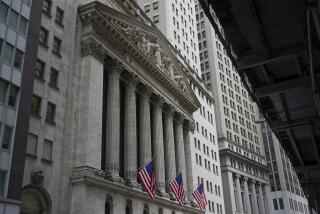Investment in New Computer Ventures Falls
- Share via
NEW YORK — Venture capital investment in computer start-ups has slackened for the first time since the market for initial public offerings in the high-tech sector began to cool two years ago, analysts say.
The decline in investment is linked to the poor performance of technology stocks this year, and analysts say it could lead to more efficient screening of new issues in the early 1990s.
“It’s like a filter,” said Sandy Robertson of Robertson Stephens and Co. “In 1983 and 1987 that filter was very coarse and a lot of junk got through.”
A recent survey conducted by Technologic Partners, which monitors the computer market, indicated that venture capital investment dropped by about 33% in the third quarter of 1989, to $252 million from $378 million in the year-ago quarter.
The study also reported that many institutional investors in venture capital funds are paring back holdings and that venture capitalists may have raised about $2 billion in 1989, or one-third of what they raised in 1988.
The decline in venture investments parallels a drop in initial public offerings, or IPOs, in high-technology companies, which were the economy’s most promising growth sector in the early 1980s. Computer-related IPOs declined from a peak of 108 in 1983 to about a dozen in 1989.
Analysts said the sharp drop in IPOs has resulted in fewer start-ups. “Venture capital follows the new-issue market,” said James Wolpert, an industry analyst at Sterling and Yorke Securities. “You don’t put money in unless you can expect to get it out soon and technology public offerings are very few, with no great enthusiasm.”
Initial offerings have also been dampened by the gloomy performance of many of the industry’s leading big-capitalization stocks, such as International Business Machines Corp. and Digital Equipment Corp.
IBM closed Friday at $95.375, down more than 25% from its high for the year of $130.875, and Digital closed at $82.75, down more than 30% from its high of $122.375. Both were trading at multiples of about 10 times estimated earnings.
Standard and Poor’s 500-stock index has risen about 25% this year, with the average stock trading at nearly 15 times estimated earnings.
Recently such wunderkind of 1980s technology growth as Compaq Computer Corp. and Sun Microsystems Inc. have also been trading at or below 10 times estimated earnings. The sector has not been helped by forecasts of continued slow growth in the industry, especially in the United States.
Nevertheless, some of this year’s recent new offerings in high technology have performed well. Shares of Symantec Corp., a maker of microcomputer software products, were issued at $10.50 and later rose more than 70% to $18 before settling lower, closing Friday at $15.
Last week, Mips Computer Systems Inc., a well-regarded pioneer in more efficient reduced instruction set computing, rose in its first two days of trading to $20 from its initial offering price of $17.50 a share. The offering price is about 22 times Wall Street’s estimates of 1990 earnings of about 80 cents a share.
Analysts said tighter funding would help the industry avoid the 1980s glut of competing companies in such areas as disk drives, portable computers and IBM-compatible personal computers, which led to many failures and consolidations.






